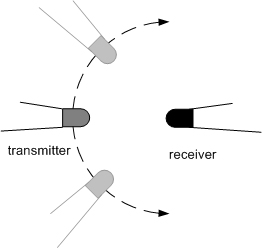Force and motion
Force and Motion
Angle
The video above shows how the light from the receiver fails to detect the IR light if the receiver doesn’t see it head on. As the angle changes away from head on, the light becomes dimmer and dimmer. The diagram below shows the same transmitter at three different angles to the reciever. Only the transmitter in the center is looking at the receiver head on.

Parabolic and spherical mirrors
To overcome the problem of getting aligning the transmitter so it is head on, the video also shows how to use a parabolic or spherical mirror to receive light that is coming in from different angles. This is the same strategy that satellite TV companies use. They surround the TV antenna with a parabolic “satellite dish” that reflects the TV signal coming in from the satellite at different angles, so the receiver can see it anyway. Automobile headlights use a similar strategy, but in reverse. They surround a small light with a parabolic mirror that spreads the light out so it looks much bigger than it really is. The diagram below shows a spherical mirror, which has almost the same shape as a parabolic mirror. You can make a spherical mirror by cutting a tennis ball in half and coating the inside surface with aluminum foil.
How a spherical mirror works
